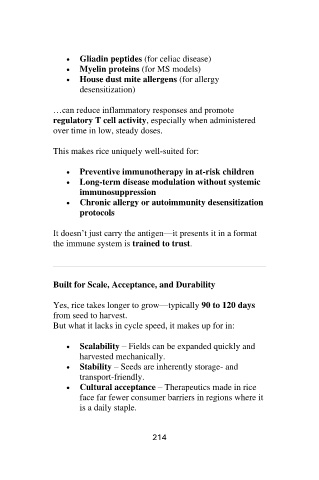Page 216 - Binder2
P. 216
• Gliadin peptides (for celiac disease)
• Myelin proteins (for MS models)
• House dust mite allergens (for allergy
desensitization)
…can reduce inflammatory responses and promote
regulatory T cell activity, especially when administered
over time in low, steady doses.
This makes rice uniquely well-suited for:
• Preventive immunotherapy in at-risk children
• Long-term disease modulation without systemic
immunosuppression
• Chronic allergy or autoimmunity desensitization
protocols
It doesn’t just carry the antigen—it presents it in a format
the immune system is trained to trust.
Built for Scale, Acceptance, and Durability
Yes, rice takes longer to grow—typically 90 to 120 days
from seed to harvest.
But what it lacks in cycle speed, it makes up for in:
• Scalability – Fields can be expanded quickly and
harvested mechanically.
• Stability – Seeds are inherently storage- and
transport-friendly.
• Cultural acceptance – Therapeutics made in rice
face far fewer consumer barriers in regions where it
is a daily staple.
214

